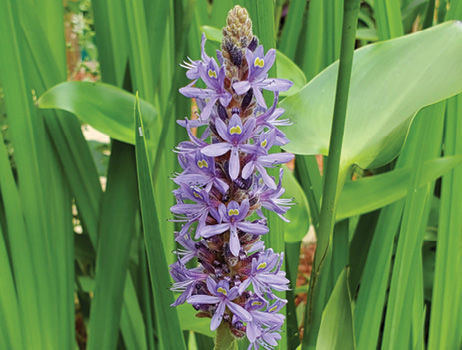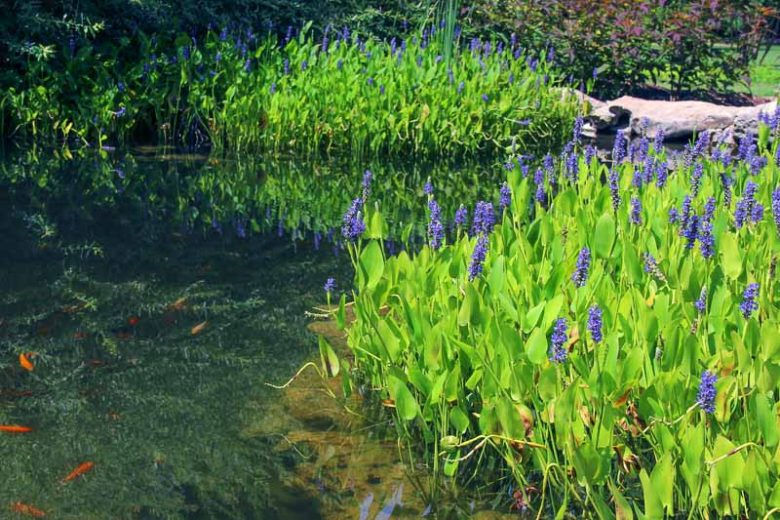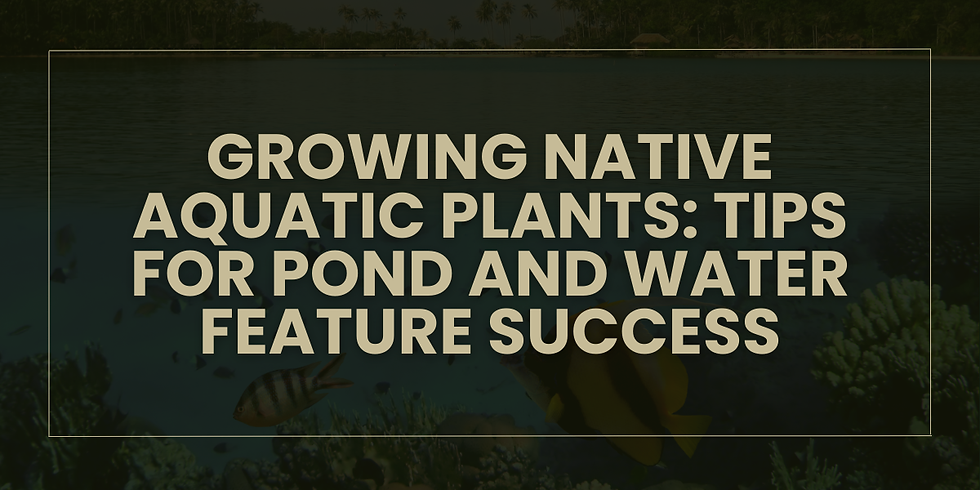Pontederia cordata: The Vibrant Pickerelweed That Enhances Wetlands and Gardens
- Devin

- Mar 1
- 8 min read
Pontederia cordata, commonly known as Pickerelweed, is a gem in aquatic gardening. With its elegant, heart-shaped leaves and striking purple flower spikes, this native wetland plant is a beautiful addition to ponds, lakes, or backyard water features. But Pickerelweed isn’t just a visual delight—it’s also an ecological powerhouse, supporting pollinators like bees and butterflies, stabilizing water edges, and improving aquatic habitats.

Whether you’re looking to enhance the aesthetics of your pond or contribute to a thriving wetland ecosystem, Pickerelweed is a perfect choice.
In this guide, we’ll walk you through everything you need to know about growing and caring for Pontederia cordata, helping you cultivate a healthy and vibrant aquatic garden.
Understanding Pontederia Cordata
Pickerelweed is as beautiful as it is functional, adding vertical interest and vibrant colors to aquatic gardens.

Native Habitat and Ecological Role
Pontederia cordata, or Pickerelweed, is a native aquatic plant found in wetlands, ponds, lakes, and slow-moving streams throughout North America. It thrives in shallow water or consistently moist soil, making it an essential plant in wetland ecosystems.
Role in the Ecosystem
Pickerelweed plays a crucial role in maintaining ecological balance:
Erosion Control: Its dense root systems stabilize pond edges, reducing soil erosion caused by water movement.
Water Quality: Pickerelweed filters water by trapping sediments and absorbing excess nutrients like nitrogen and phosphorus, helping to prevent algae blooms.
Wildlife Habitat: Its submerged roots provide shelter for fish and aquatic insects, while its flowers attract pollinators such as bees and butterflies.
Foliage

Its glossy, heart-shaped leaves are one of its most striking features. These leaves can grow up to 10 inches long and rise gracefully above the water’s surface, adding texture and lush greenery to water gardens.
Flowers

The dense spikes of purple blooms are a hallmark of Pickerelweed, appearing from late spring through early fall. Each flower spike consists of small individual flowers, often visited by pollinators like bumblebees and butterflies.
Growth Habit

Source: Gardenia Creativity Gardens - Pontederia Cordata
Pickerelweed grows in upright clumps, typically reaching 2–4 feet in height. Its spreading nature allows it to form dense stands over time, creating a natural border for ponds and lakes.
Ecological and Aesthetic Benefits
1. Attracting Pollinators and Wildlife
Pickerelweed’s nectar-rich flowers are a favorite for bees, butterflies, and other pollinators. Birds often forage for insects near its dense foliage, and aquatic species like fish find shelter among its roots.
2. Improving Water Quality
Pickerelweed’s ability to absorb excess nutrients reduces the risk of algae blooms, creating a healthier aquatic environment. Its filtering action also improves water clarity, making it an ideal choice for backyard ponds.
3. Adding Visual Appeal
The plant’s tall, upright stems and vibrant flowers make it a striking focal point in any water garden. Its lush green foliage contrasts beautifully with other aquatic plants, creating a dynamic and inviting landscape.
Interesting Fact
Pickerelweed produces small seeds that float on water, and these seeds are a food source for ducks and other waterfowl.
With its combination of ecological benefits, low-maintenance nature, and stunning beauty, Pontederia cordata is a must-have for anyone looking to enhance their aquatic or wetland garden. Understanding its natural habitat and role in the ecosystem ensures that you can grow Pickerelweed successfully while contributing to the health of your pond or water feature.
Ideal Growing Conditions for Pickerelweed 🌿💧
To grow Pickerelweed successfully, it’s essential to mimic its natural wetland habitat.
Light
Pickerelweed thrives in full sun to partial shade, with full sun promoting the best flowering. In warmer climates, partial shade helps prevent overheating.
Water

As an aquatic plant, Pickerelweed requires shallow water (6–12 inches deep) or moist soil. It’s ideal for planting along the edges of ponds, in water gardens, or in naturally soggy areas.
Soil

Pickerelweed grows best in nutrient-rich, loamy, or sandy soil. When using aquatic pots, opt for heavy clay-based soil to anchor the roots and prevent the soil from floating away.
Climate

Pickerelweed is hardy in USDA Zones 3–10 (Shaded parts), making it adaptable to a wide range of climates. It tolerates both warm, humid summers and cold winters with proper care.
Planting Pickerelweed
Pickerelweed is easy to plant and establishes quickly when planted in suitable conditions. Following a proper planting method ensures healthy growth and abundant blooms throughout the season.
Best Planting Season
The ideal time to plant Pickerelweed is in spring or early summer, once water temperatures have warmed and the risk of frost has passed. This gives the plant ample time to establish before winter.
Step-by-Step Planting Guide
1. Choose the Right Location
Pickerelweed thrives in shallow water or along pond edges. Select a spot where the water depth is 6–12 inches or the soil stays consistently moist. Ensure the location receives plenty of sunlight, as this promotes vigorous growth and abundant flowering.
2. Decide on a Planting Method
Direct Planting in Soil:
For natural ponds or wetlands, plant Pickerelweed directly in the pond bed or shoreline. Dig a shallow hole, place the root ball, and cover it with soil.
Ensure the roots are submerged but not buried too deeply, as this may impede growth.
Planting in Aquatic Pots or Baskets:
Aquatic pots or mesh baskets are ideal for controlling the spread of Pickerelweed. Fill the container with heavy, clay-based soil, which helps anchor the plant.
Cover the soil with a layer of gravel to prevent it from floating away and to keep the plant securely in place.
3. Spacing and Depth
Spacing: Place Pickerelweed plants 12–18 inches apart to allow ample room for growth and prevent overcrowding.
Water Depth: Ensure the roots are submerged in 6–12 inches of water, with the foliage extending above the surface. This mimics the plant’s natural habitat and supports optimal growth.
4. Anchor the Roots
If planting directly in the pond bed, use small stones to secure the roots and prevent the plant from floating away due to water currents or wildlife movement.
5. Monitor Initial Growth
After planting, monitor the plant’s progress for the first few weeks. Ensure the water level remains consistent, and check for any signs of stress, such as yellowing leaves or drooping stems.
Tips for Success
Start Small: If you’re new to aquatic gardening, begin with one or two plants and gradually expand. Pickerelweed spreads over time, so starting small prevents overcrowding.
Use Aquatic Fertilizer: Add a slow-release aquatic fertilizer tablet to the soil during planting. This boosts initial growth and encourages healthy blooms.
Planting Benefits
Proper planting not only ensures a thriving Pickerelweed plant but also contributes to the overall health and stability of your water garden. A well-placed Pickerelweed stand can:
Prevent erosion by stabilizing soil along pond edges.
Filter water naturally, reducing excess nutrients that can lead to algae growth.
Provide a safe haven for aquatic life and pollinators.
By following these simple steps, you’ll set your Pickerelweed plants up for success, creating a lush, vibrant addition to your pond or water garden.
Caring for Pontederia Cordata
Once established, Pickerelweed requires minimal maintenance but benefits from a few key care practices:
Watering
Pickerelweed thrives in consistently wet environments. Ensure the roots remain submerged in shallow water or the soil stays moist.
Fertilization
Use an aquatic fertilizer sparingly during the growing season to encourage robust growth and flowering. Avoid over-fertilizing, as this can lead to nutrient imbalances in the water.
Pruning and Maintenance
Remove Dead Foliage: Regularly prune yellowing or decaying leaves to maintain the plant’s appearance and health.
Annual Trimming: Thin out dense clusters once a year to prevent overgrowth and maintain balance in your water garden.
Winter Care
Hardy in Most Climates: In cold regions, trim back the foliage after the first frost.
Prevent Freezing: Ensure the roots remain submerged to avoid damage during freezing temperatures.
Common Issues and How to Solve Them
1. Yellowing Leaves

Cause: Often due to nutrient deficiencies or poor water quality.
Solution: Add aquatic fertilizer to improve nutrient levels and test water quality to address any imbalances.
2. Pests

Cause: Occasionally, Pickerelweed may attract aphids or snails.
Solution: Spray aphids off with water or introduce natural predators like ladybugs. Manually remove snails or use snail traps.
3. Overgrowth

Cause: Pickerelweed can spread aggressively in ideal conditions.
Solution: Divide and thin out the plant annually to prevent it from overwhelming your pond.
Companion Plants for Pickerelweed
Creating a visually dynamic and ecologically balanced aquatic garden involves pairing Pickerelweed with other complementary plants. Companion plants not only enhance the beauty of your garden but also support biodiversity and improve water quality.
1. Water Smartweed (Polygonum amphibium)

Water Smartweed, with its trailing stems and delicate pink flowers, is an excellent companion for Pickerelweed. It contrasts with Pickerelweed’s upright growth habit and adds a softer, more cascading element to your garden.
Why It’s a Good Match:
Its trailing growth complements Pickerelweed’s vertical structure.
Attracts additional pollinators, creating a more vibrant ecosystem.
Growing Tip:
Plant Water Smartweed in shallow water areas similar to Pickerelweed’s preferred habitat for optimal growth.
2. White Water Lily (Nymphaea odorata)

White Water Lilies are iconic aquatic plants that create a striking contrast with Pickerelweed. Their large, floating leaves and pristine white flowers balance the upright, purple blooms of Pickerelweed.
Why It’s a Good Match:
The combination of floating and emergent plants adds depth and variety to the garden.
Water Lilies help shade the water, reducing algae growth and maintaining a healthy pond environment.
Growing Tip:
Position Water Lilies in slightly deeper areas of the pond to prevent competition for space.
3. Creeping Jenny (Lysimachia nummularia)
Creeping Jenny is a low-growing plant with vibrant green leaves and cheerful yellow flowers. It’s an excellent ground cover that enhances shoreline aesthetics and provides a cascading effect along the edges of ponds.
Why It’s a Good Match:
Adds a contrasting texture to Pickerelweed’s upright stems.
Spreads quickly, helping to stabilize soil along pond edges.
Growing Tip:
Plant Creeping Jenny in moist soil or shallow water at the pond’s edge for best results.
4. Broadleaf Arrowhead (Sagittaria latifolia)

Broadleaf Arrowhead, also known as Duck Potato, features arrow-shaped leaves and white flowers that bloom in summer. It thrives in similar conditions as Pickerelweed and adds another layer of visual interest to the garden.
Why It’s a Good Match:
Both plants share similar water depth and soil preferences, making them easy to grow together.
Attracts pollinators and supports aquatic life.
Growing Tip:
Plant Broadleaf Arrowhead near Pickerelweed to create a lush, multi-layered effect in your water garden.
5. Cardinal Flower (Lobelia cardinalis)

The Cardinal Flower is a native wetland plant with vibrant red blooms that create a striking color contrast with Pickerelweed’s purple flowers. Its upright growth and similar habitat preferences make it a perfect companion.
Why It’s a Good Match:
Adds a bold pop of color to the garden.
Attracts hummingbirds, enhancing biodiversity.
Growing Tip:
Position Cardinal Flower slightly higher on the shoreline for a natural, tiered look.
By combining Pickerelweed with these complementary plants, you can design a water garden that’s visually stunning and ecologically balanced. Each plant brings its unique beauty and benefits, creating a harmonious and thriving aquatic ecosystem.
To enhance your understanding of planting and caring for bareroot aquatic plants, particularly the White Water Lily (Nymphaea odorata), here's an informative YouTube video that provides a step-by-step guide:
FAQs: Common Questions About Pontederia Cordata
Q: Can Pickerelweed grow in full shade?
Pickerelweed prefers full sun to partial shade. While it can tolerate some shade, limited sunlight may reduce flowering and overall vigor.
Q: How do I propagate Pickerelweed?
Pickerelweed is easy to propagate by dividing mature clumps. Separate the root system into smaller sections and replant them in suitable conditions during spring or summer.
Q: Is Pickerelweed invasive?
In its native range, Pickerelweed is not considered invasive. However, it can spread rapidly in ideal conditions, so regular thinning is recommended to maintain balance.
Q: Do I need to fertilize Pickerelweed?
Fertilizing is optional but beneficial. Use a slow-release aquatic fertilizer during the growing season to encourage healthy growth and abundant flowering.
Ready to Add Pickerelweed to Your Water Garden?
Pontederia cordata is a versatile and stunning addition to any water garden. Its vibrant flowers, ecological benefits, and low-maintenance nature make it a favorite for gardeners looking to create a thriving aquatic ecosystem.
Need Help Choosing Aquatic Plants?
Our team is here to guide you in selecting the perfect plants for your pond or water garden. From companion plants to essential care tips, we’ll help you achieve a lush, balanced landscape.
Shop Our Collection of Aquatic Plants Today!
Explore our curated selection of Pickerelweed, companion plants, and aquatic gardening tools. Together, let’s create a beautiful, sustainable water garden that supports nature and enhances your outdoor space.




Comments